Calculation of Consistent Plasma Parameters for DEMO-FNS Using Ionic Transport Equations and Simulation of the Tritium Fuel Cycle
Abstract
:Featured Application
Abstract
1. Introduction
2. Transport Model
- (i)
- Feedback over the average density: the particle flow from the pellets (D + T) is chosen to provide the required value <ne> = (6–8) × 1019 m−3.
- (ii)
- Feedback over energy confinement time: the ion and electron heat conductivity coefficients χe = χi are chosen so as to provide the required value of the factor HIPB(y,2) = 1.3.
- (iii)
- Feedback over particle confinement time: the value of constant Cn is chosen to satisfy the given value τp/τE = 0.75–3.0.
- (iv)
- Feedback over the fraction of tritium in the pellets: the flow from the pellets is divided between D and T to provide the required value f T = 0.5.
3. Calculation Results
3.1. Particle Flows
3.2. Confinement Times
3.3. ELM Control by Pellet Injection
- (a)
- the size of the pellets required for reliable stimulation of ELMs and changes in the flows of fuel components in the FC caused by it;
- (b)
- the geometry of pellet injection for fueling the plasma and stimulating ELMs;
- (c)
- the effect of this control method on the parameters of density pedestal of the core plasma and, consequently, its confinement and the characteristics of the neutron source.
3.4. Gas Puffing into the Vacuum Vessel
- -
- the upper pipeline contains 18 branches, each of which consists of a 264-mm-diameter opening, a 264-mm-diameter 6900-mm-long pipeline, a 90° bend, and a further length of 304-mm-diameter 2200-mm-long pipeline;
- -
- the lower pipeline also contains 18 branches, each of which contains a 264-mm-diameter opening, a 264-mm-diameter 5330-mm-long pipeline, a 90° bend, and a further length of 304-mm-diameter 2284-mm-long pipeline.
3.5. Parameters of the Neutron Source
3.6. Tritium Inventories
4. Conclusions
Author Contributions
Funding
Institutional Review Board Statement
Informed Consent Statement
Data Availability Statement
Acknowledgments
Conflicts of Interest
References
- Abdou, M.; Riva, M.; Ying, A.; Day, C.; Loarte, A.; Baylor, L.R.; Humrickhouse, P.; Fuerst, T.F.; Cho, S. Physics and technology considerations for the deuterium–tritium fule cycle and conditions for the fuel self sufficiency. Nucl. Fusion 2021, 61, 013001. [Google Scholar] [CrossRef]
- Tokar, M.Z.; Moradi, S. Optimization of isotope composition of fusion plasmas. Nucl. Fusion 2011, 51, 063013. [Google Scholar] [CrossRef]
- Belli, E.A.; Candy, J. Asymmetry between deuterium and tritium turbulent particle flows. Phys. Plasmas 2021, 28, 062301. [Google Scholar] [CrossRef]
- Abdou, M.A.; Vold, E.L.; Gung, C.Y.; Youssef, M.Z.; Shin, K. Deuterium–tritium fuel self-sufficiency in fusion reactors. Fusion Technol. 1986, 9, 250–285. [Google Scholar] [CrossRef]
- Reux, C.; Kahn, S.; Zani, L.; Pégourié, B.; Piot, N.; Owsiak, M.; Aiello, G.; Artaud, J.-F.; Boutry, A.; Dardour, S.; et al. DEMO design using the SYCOMORE system code: Influence of technological constraints on the reactor performances. Fusion Eng. Des. 2018, 136, 1572–1576. [Google Scholar] [CrossRef] [Green Version]
- Ananyev, S.S.; Dnestrovskij, A.Y.; Kukushkin, A.S.; Spitsyn, A.V.; Kuteev, B.V. Architecture of fuel systems of hybrid facility DEMO-FNS and algorithms for calculation of fuel flows in the FC-FNS model. Fusion Sci. Technol. 2020, 76, 503. [Google Scholar] [CrossRef]
- Ananyev, S.S.; Dnestrovsky, A.Y.; Kukushkin, A.S. Integrated modeling of fuel flows in the plasma and in the injection and pumping systems for the demo-fns fusion neutron source. Probl. At. Sci. Technol. Ser. Thremonucl. Fusion 2020, 43, 96–109. [Google Scholar] [CrossRef]
- Ananyev, S.S.; Dnestrovskij, A.Y.; Kukushin, A.S. Fluxes in DEMO-FNS Fuel Cycle Systems with Allowance for Injection of D and T Pellets. Plasma Phys. Rep. 2022, 48, 205–219. [Google Scholar] [CrossRef]
- Pacher, H.D.; Kukushkin, A.S.; Pacher, G.W.; Kotov, V.; Pitts, R.A.; Reiter, D. Impurity seeding in ITER in a carbon-free environment. J. Nucl. Mater. 2015, 463, 591. [Google Scholar] [CrossRef]
- Pereverzev, G.V.; Yushmanov, P.N. Report ID 282186; Max-Planck-Institut für Plasmaphysik: Garching bei München, Germany, 2002. [Google Scholar]
- Kukushkin, A.S.; Pacher, H.D.; Kotov, V.; Pacher, G.W.; Reiter, D. Finalizing the ITER divertor design: The key role of SOLPS modeling. Fusion Eng. Des. 2011, 86, 2865. [Google Scholar] [CrossRef]
- Ananyev, S.S.; Spitsyn, A.V.; Kuteev, B.V. Electronic model «FC-FNS» of the fusion neutron source DEMO-FNS fuel cycle and modeling hydrogen isotopes flows and inventories in fueling systems. Fusion Eng. Des. 2019, 138, 289. [Google Scholar] [CrossRef]
- Dnestrovskiy, A.Y.; Kukushkin, A.S.; Kuteev, B.V.; Sergeev, V.Y. Integrated Modelling of Core and Divertor Plasmas for the DEMO Fusion Neutron Source Hybrid Facility. Nucl. Fusion 2019, 59, 096053. [Google Scholar] [CrossRef]
- Tokar, M.Z.; Kotov, V. Modelling the transport of deuterium and tritium neutral particles in a divertor plasma. Nucl. Fusion 2012, 52, 103004. [Google Scholar] [CrossRef]
- Schneider, P.A.; Hennequin, P.; Bonanomi, N.; Dunne, M.; Conway, G.D.; Plank, U.; the ASDEX Upgrade Team; the EUROfusion MST1 Team. Overview of the isotope effects in the ASDEX Upgrade tokamak. Plasma Phys. Control. Fusion 2021, 63, 064006. [Google Scholar] [CrossRef]
- Dnestrovskiy, A.Y.; Kuteev, B.V.; Bykov, A.S.; Ivanov, A.A.; Lukash, V.E.; Medvedev, S.Y.; Sergeev, V.Y.; Sychugov, D.Y.; Khayrutdinov, R.R. Integrated modelling of DEMO-FNS current ramp-up scenario and steady-state regime. Nucl. Fusion 2015, 55, 063007. [Google Scholar] [CrossRef] [Green Version]
- Dnestrovskiy, A.Y.; Kukushkin, A.S.; Kuteev, B.V.; Sergeev, V.Y. Helium ash removal in DEMO-FNS, TH/P1-22. In Proceedings of the 28th IAEA Fusion Energy Conference, Virtual Event, 10–15 May 2021. [Google Scholar]
- Polevoi, A.R.; Shimada, M.; Sugihara, M.; Igitkhanov, Y.L.; Mukhovatov, V.S.; Kukushkin, A.S.; Medvedev, S.Y.; Zvonkov, A.V.; Ivanov, A.A. Requirements for pellet injection in ITER scenarios with enhanced particle confinement. Nucl. Fusion 2005, 45, 1451. [Google Scholar] [CrossRef]
- Valovič, M.; Meyer, H.; Akers, R.; Brickley, C.; Conway, N.J.; Cunningham, G.; Kirk, A.; Lloyd, B.; Patel, A.; Taylor, D.; et al. Energy and particle confinement in MAST. Nucl. Fusion 2005, 45, 942. [Google Scholar] [CrossRef]
- Porter, G.D.; the DIII-D team. The role of radial particle flow on power balance in DIII-D. Phys. Plasmas 1998, 5, 12. [Google Scholar] [CrossRef]
- Ananyev, S.S.; Ivanov, B.V.; Kuteev, B.V. Analysis of promising technologies of DEMO-FNS fuel cycle. Fusion Eng. Des. 2020, 161, 111940. [Google Scholar] [CrossRef]
- Ananyev, S.S.; Ivanov, B.V.; Dnestrovskij, A.Y.; Kukushkin, A.S.; Spitsyn, A.V.; Kuteev, B.V. Concept development and candidate technologies selection for the DEMO–FNS fuel cycle systems. Nucl. Fusion 2021, 61, 116062. [Google Scholar] [CrossRef]
- Loarte, A.; Huijsmans, G.; Futatani, S.; Baylor, L.R.; Evans, T.E.; Orlov, D.M.; Schmitz, O.; Becoulet, M.; Cahyna, P.; Gribov, Y.; et al. Progress on the application of ELM control schemes to ITER scenarios from the non-active phase to DT operation. Nucl. Fusion 2014, 54, 033007. [Google Scholar] [CrossRef]
- Loarte, A.; Becoulet, M.; Saibene, G.; Sartori, R.; Campbell, D.J.; Eich, T.; Herrmann, A.; Laux, M.; Suttrop, W.; Alper, B.; et al. Characteristics and scaling of energy and particle losses during Type I ELMs in JET H-modes. Plasma Phys. Control. Fusion 2002, 44, 1815. [Google Scholar] [CrossRef] [Green Version]
- Leonard, A.W.; Herrmann, A.; Itami, K.; Lingertat, J.; Loarte, A.; Osborne, T.H.; Suttrop, W. The ITER divertor modeling, database expert group, the ITER divertor physics expert group. J. Nucl. Mater. 1999, 266–269, 109. [Google Scholar] [CrossRef] [Green Version]
- Futatani, S.; Huijsmans, G.; Loarte, A.; Baylor, L.R.; Commaux, N.; Jernigan, T.C.; Pegourié, B. Non-linear MHD modelling of ELM triggering by pellet injection in DIII-D and implications for ITER. Nucl. Fusion 2014, 54, 073008. [Google Scholar] [CrossRef]
- Baylor, L.R.; Jernigan, T.C.; Commaux, N.; Combs, S.K.; Meitner, S.J.; Brooks, N.H.; Evans, T.E.; Fenstermacher, M.E.; Lasnier, C.J.; Moyer, R.A.; et al. Experimental demonstration of high frequency ELM pacing by pellet injection on DIII–D and extrapolation to ITER. 2012. In Proceedings of the 24th International Conference on Fusion Energy, San Diego, CA, USA, 8–13 October 2012; [EX/6-2]. Available online: www-naweb.iaea.org/napc/physics/FEC/FEC2012/index.htm (accessed on 11 May 2023).
- Ananyev, S.; Dnestrovskij, A.; Kukushkin, A. Selection of Fuel Isotope Composition in Heating Injectors of the FNS-ST Compact Fusion Neutron Source. Appl. Sci. 2021, 11, 7565. [Google Scholar] [CrossRef]
- Pankin, A.; McCune, D.; Andre, R.; Bateman, G.; Kritz, A. The tokamak Monte Carlo fast ion module NUBEAM in the National Transport Code Collaboration library. Comput. Phys. Commun. 2004, 159, 157–184. [Google Scholar] [CrossRef]
- Goldston, R.J. Heuristic drift-based model of the power scrape-off width in low-gas-puff H-mode tokamaks. Nucl. Fusion 2012, 52, 013009. [Google Scholar] [CrossRef] [Green Version]
- Hughes, J.W.; Hubbard, A.E.; Mossessian, D.A.; LaBombard, B.; Biewer, T.M.; Granetz, R.S.; Greenwald, M.; Hutchinson, I.H.; Irby, J.H.; Lin, Y.; et al. H-Mode Pedestal and L-H Transition Studies on Alcator C-Mod. Fusion Sci. Technol. 2007, 51, 317–341. [Google Scholar] [CrossRef]
- Whyte, D.G.; Hubbard, A.E.; Hughes, J.W.; Lipschultz, B.; Rice, J.E.; Marmar, E.S.; Greenwald, M.; Cziegler, I.; Dominguez, A.; Golfinopoulos, T.; et al. I-mode: An H-mode energy confinement regime with L-mode particle transport in Alscator C-Mod. Nucl. Fusion 2010, 50, 105005. [Google Scholar] [CrossRef] [Green Version]
- Sergeev, V.Y.; Bakhareva, O.A.; Kuteev, B.V.; Tendler, M. Studies of the impurity pellet ablation in the high-temperature plasma of magnetic confinement devices. Plasma Phys. Rep. 2006, 32, 363–377. [Google Scholar] [CrossRef]
- Koechl, F.; Pégourié, B.; Matsuyama, A.; Nehme, H.; Waller, V.; Frigione, D.; Garzotti, L.; Kamelander, G.; Parail, V.; JET EFDA Contributors. Modelling of Pellet Particle Ablation and Deposition: The Hydrogen Pellet Injection code HPI2. 2014. preprint. Available online: https://scipub.euro-fusion.org/wp-content/uploads/2014/11/EFDP12057.pdf (accessed on 11 May 2023).
- Polevoi, A.R.; Shimada, M. Simplified mass ablation and relocation treatment for pellet injection optimization. Plasma Phys. Control. Fusion 2001, 43, 1525–1533. [Google Scholar] [CrossRef]
- Zhang, J.; Parks, P. Analytical formula for pellet fuel source density in toroidal plasma configurations based on an areal deposition model. Nucl. Fusion 2020, 60, 066027. [Google Scholar] [CrossRef]
- Kukushkin, A.S. Role of hydrogen exchange of the plasma with material surfaces in the fusion reactor. In 11th International School for Young Scientists and Specialists IHISM 16 Junior; Book of Abstracts; Yukhimchuk, A.A., Ed.; RFNC-VNIIEF: Sarov, Russia, 2017. [Google Scholar]
- Kukushkin, A.S.; Sergeev, V.Y.; Kuteev, B.V. Analysis of pumping conditions in DEMO-FNS. In Proceedings of the 46th EPS Conference on Plasma Physics EPS-2019, Milan, Italy, 8–12 July 2019; Available online: https://ocs.ciemat.es/EPS2019PAP/pdf/P2.1012.pdf (accessed on 10 May 2023).
- Kuteev, B.V.; Shpanskiy, Y.S.; DEMO-FNS Team. Status of DEMO-FNS development. Nucl. Fusion 2017, 57, 076039. [Google Scholar] [CrossRef]
- Shpanskiy, Y.S.; DEMO-FNS Project Team. Progress in the design of the DEMO-FNS hybrid facility. Nucl. Fusion 2019, 59, 076014. [Google Scholar] [CrossRef] [Green Version]
- Ananyev, S.S.; Dnestrovskij, A.Y.; Kukushkin, A.S.; Spitsyn, A.V.; Kuteev, B.V. Integration of coupled modeling of the core and divertor plasmas into “FC-FNS” code and application to DEMO-FNS project. Fusion Eng. Des. 2020, 155, 111562. [Google Scholar] [CrossRef]
- Ananyev, S.; Dnestrovskij, A.; Kukushkin, A.; Ivanov, B.; Kuteev, B. Choice of Gas Isotope Composition for Neutral Beam Injectors of the FNS-ST Compact Fusion Neutron Source. Fusion Sci. Technol. 2023, 79, 381–398. [Google Scholar] [CrossRef]

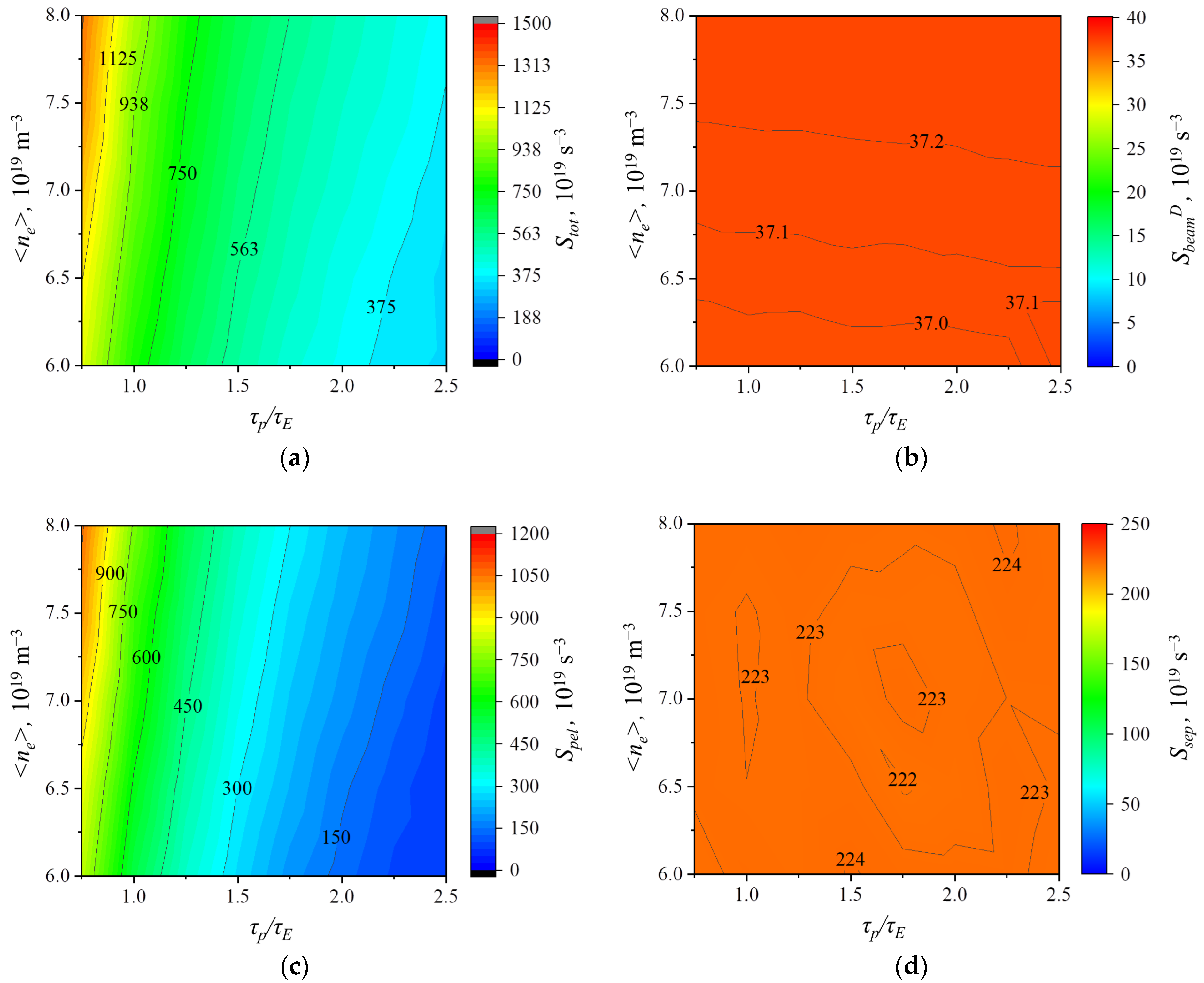
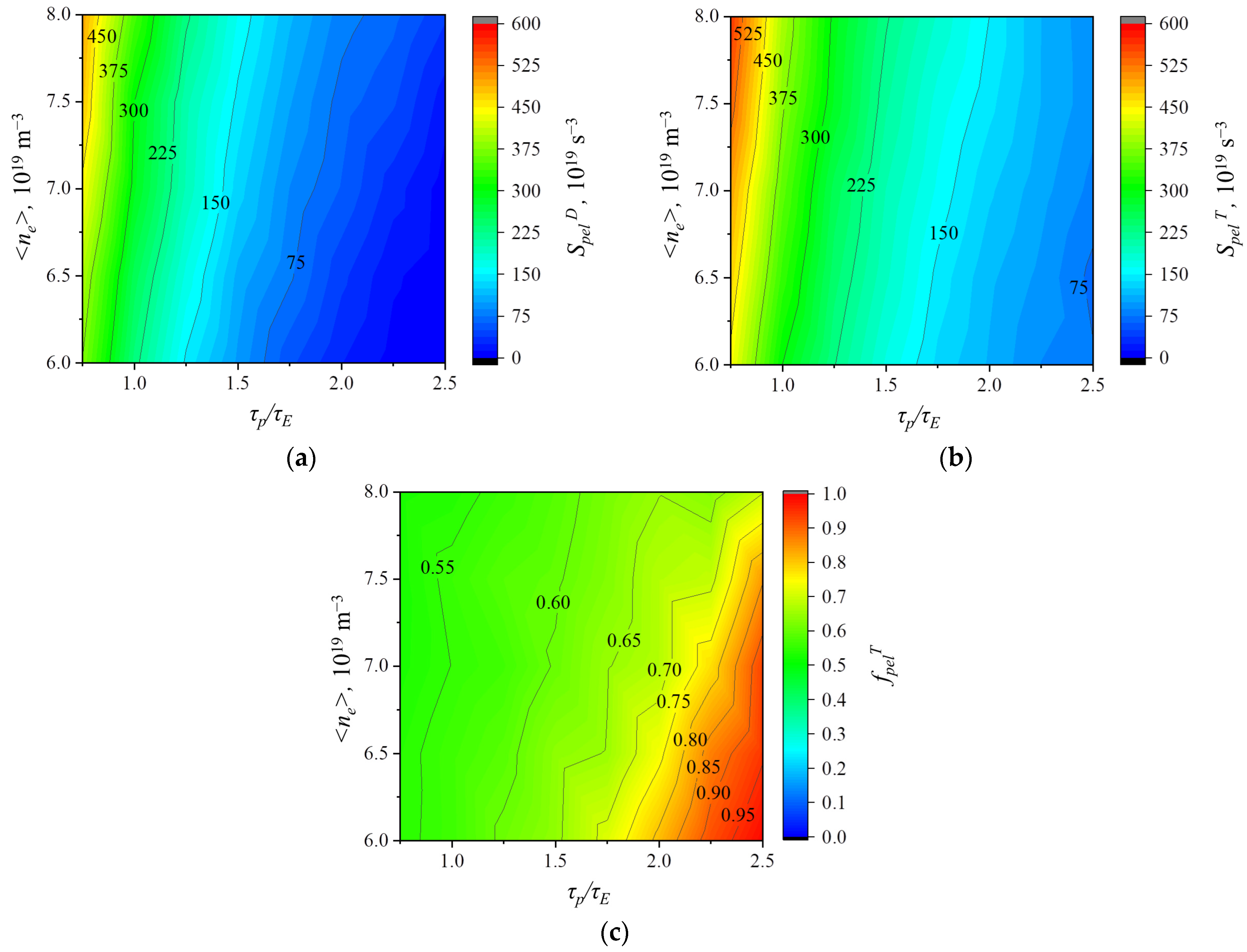
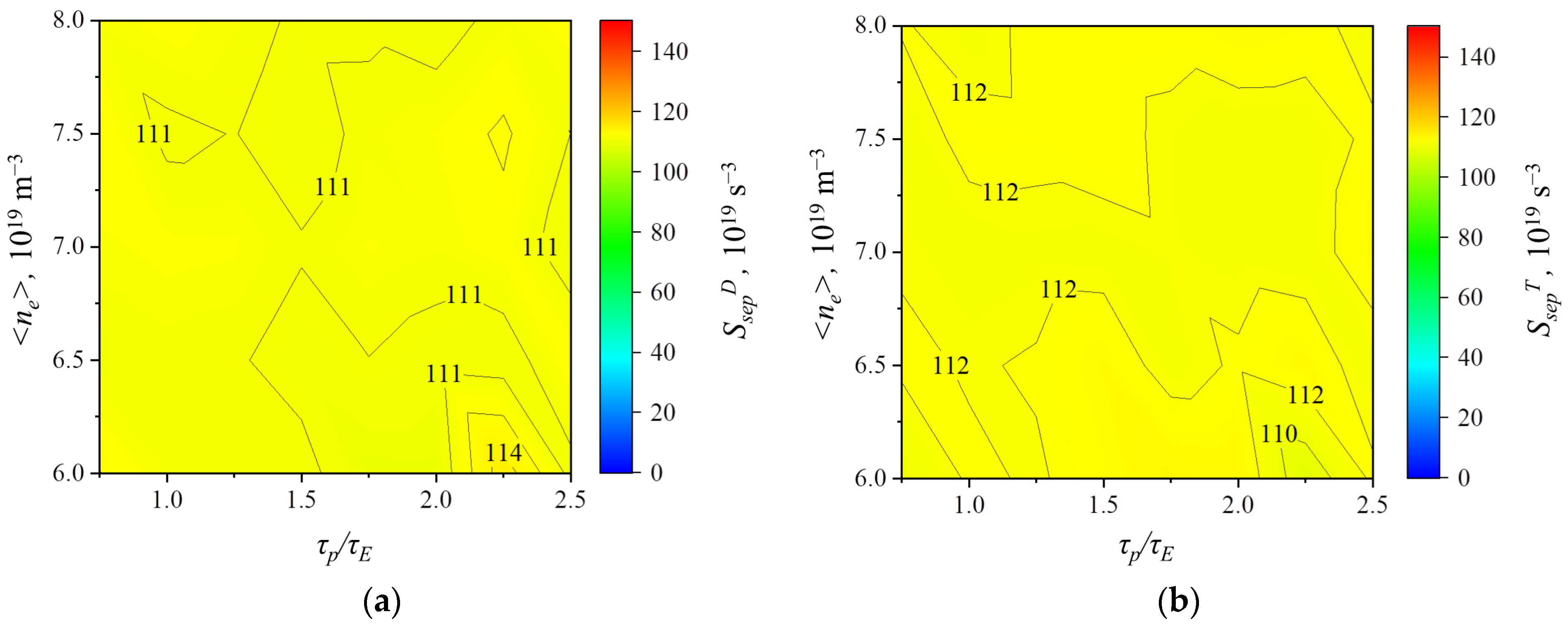
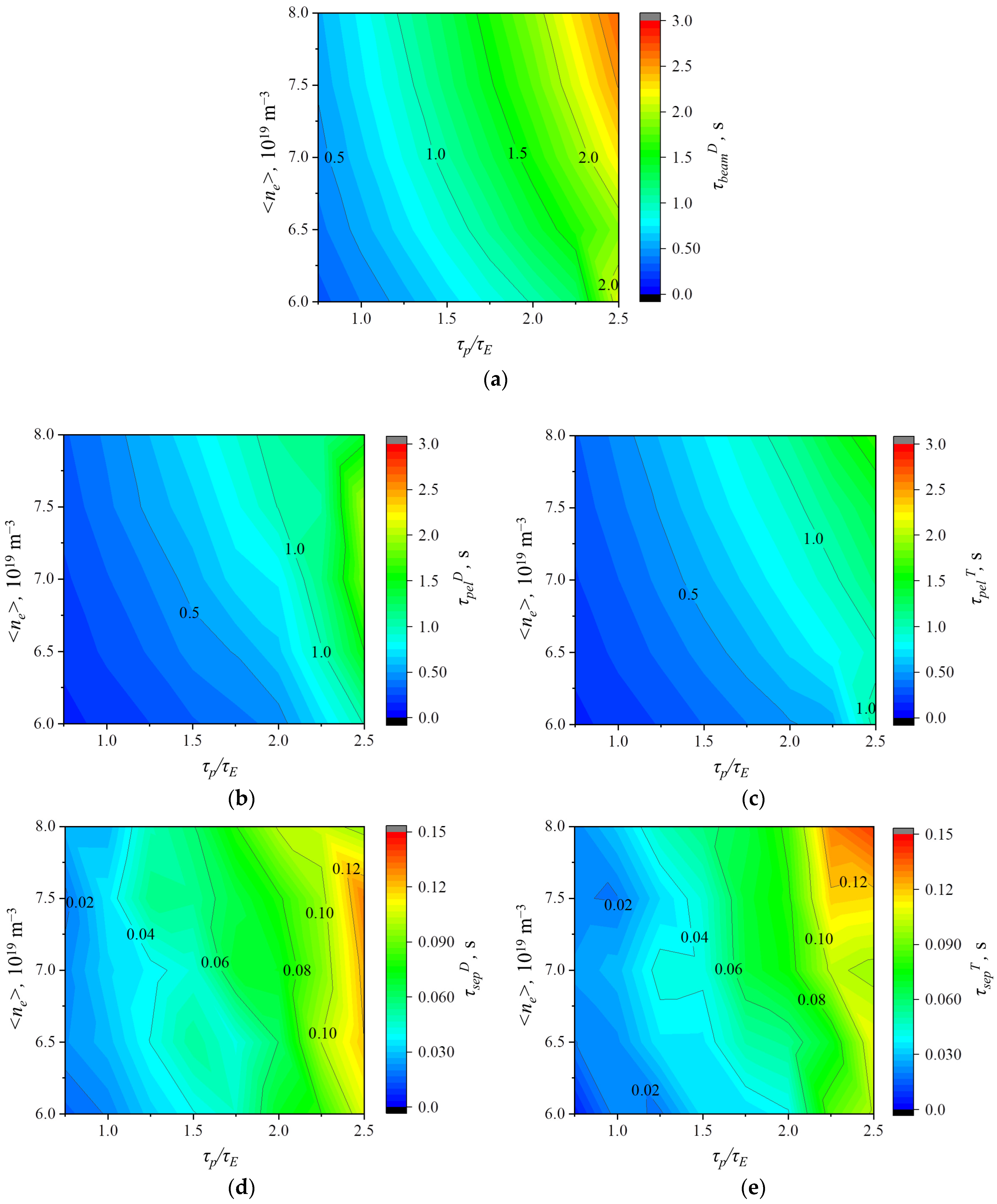
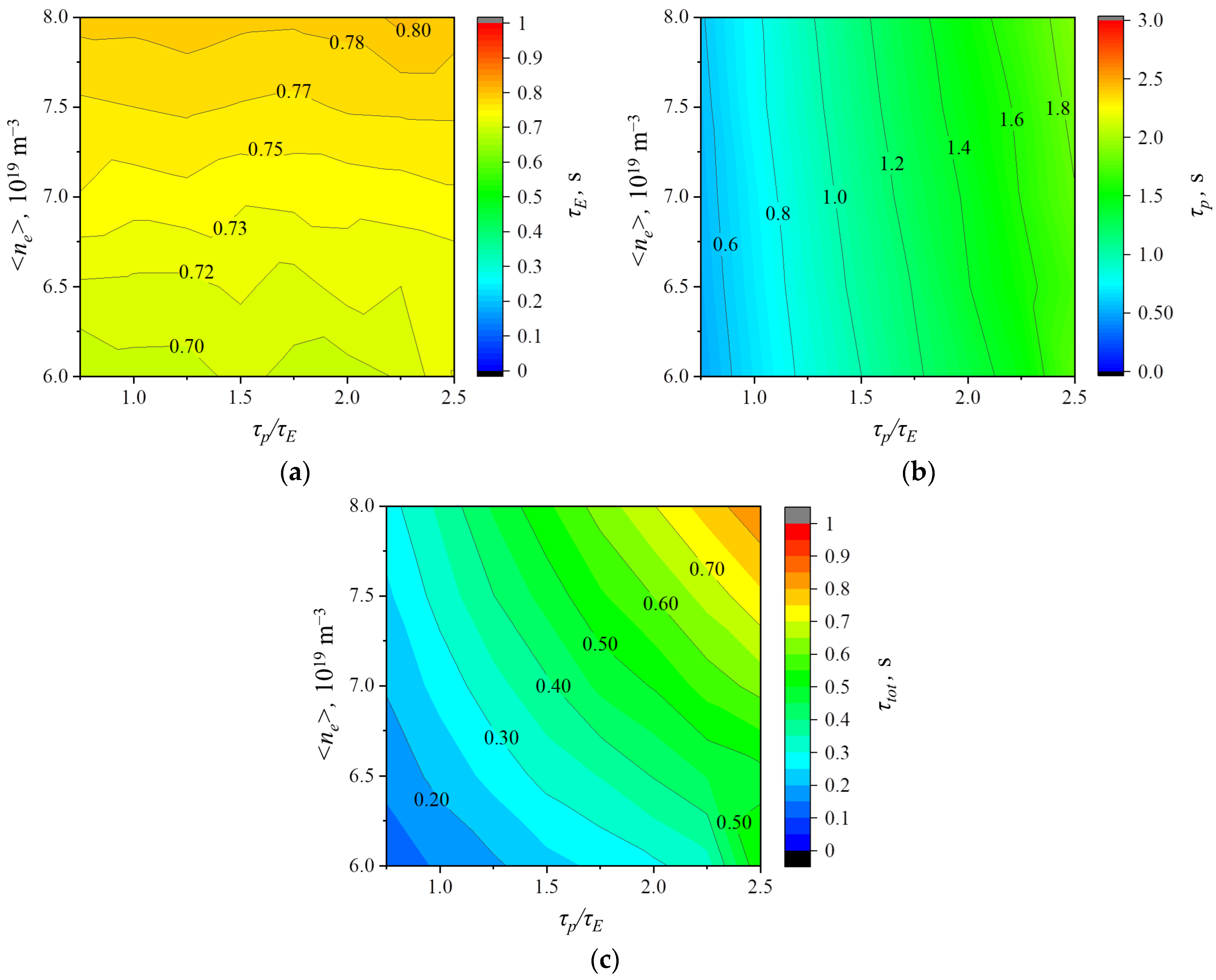

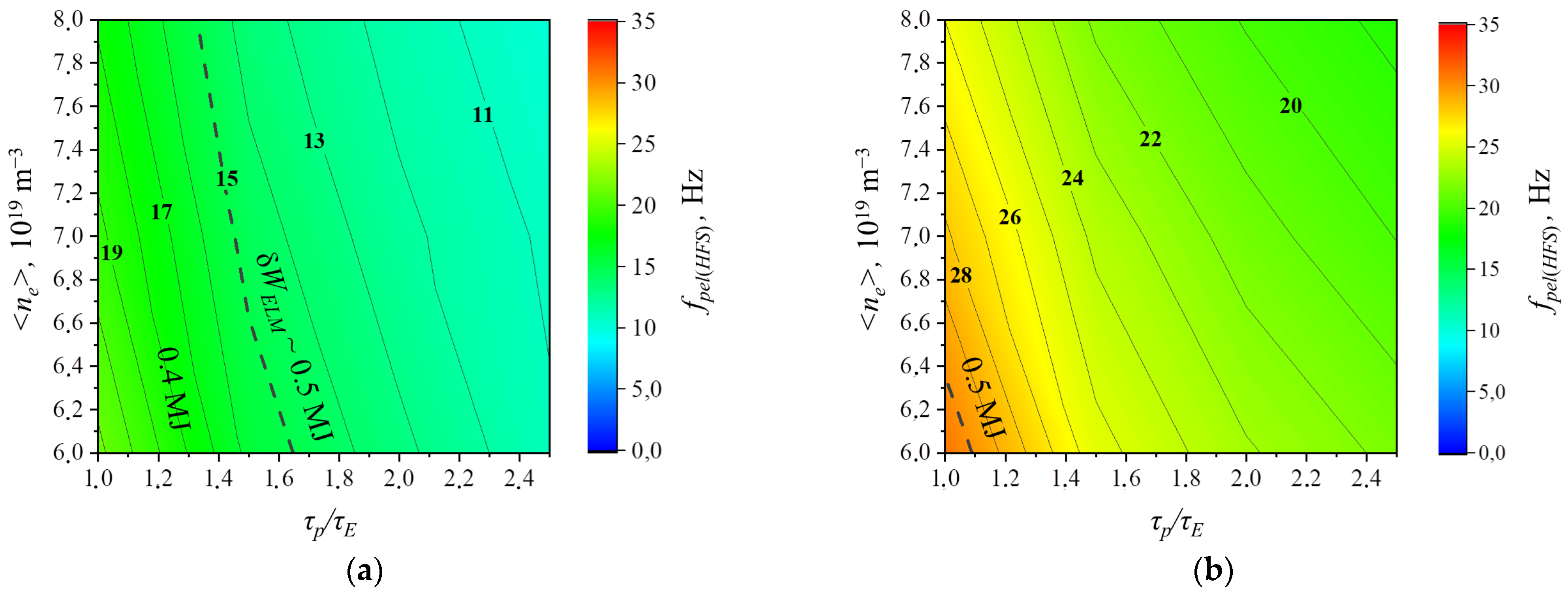
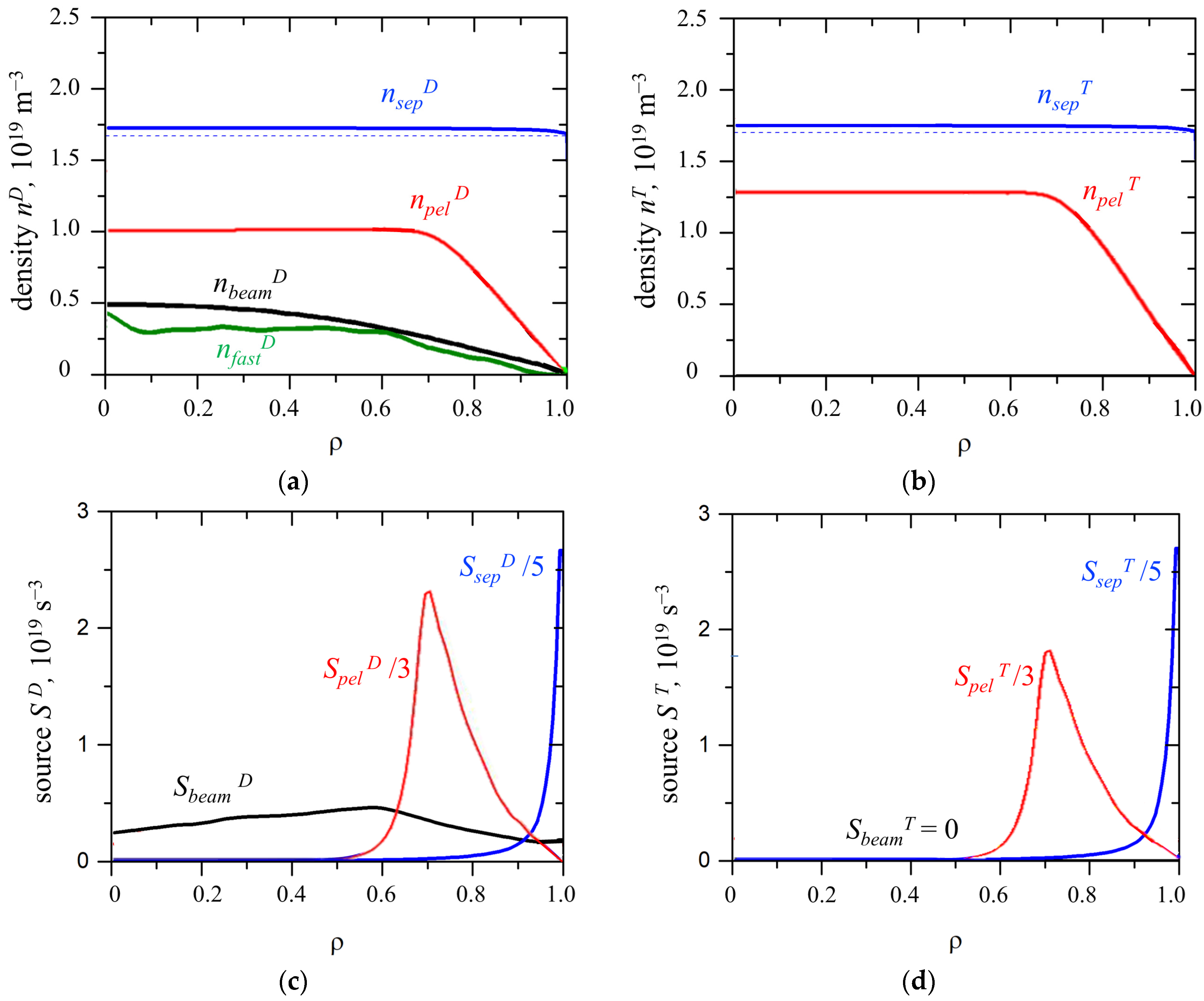

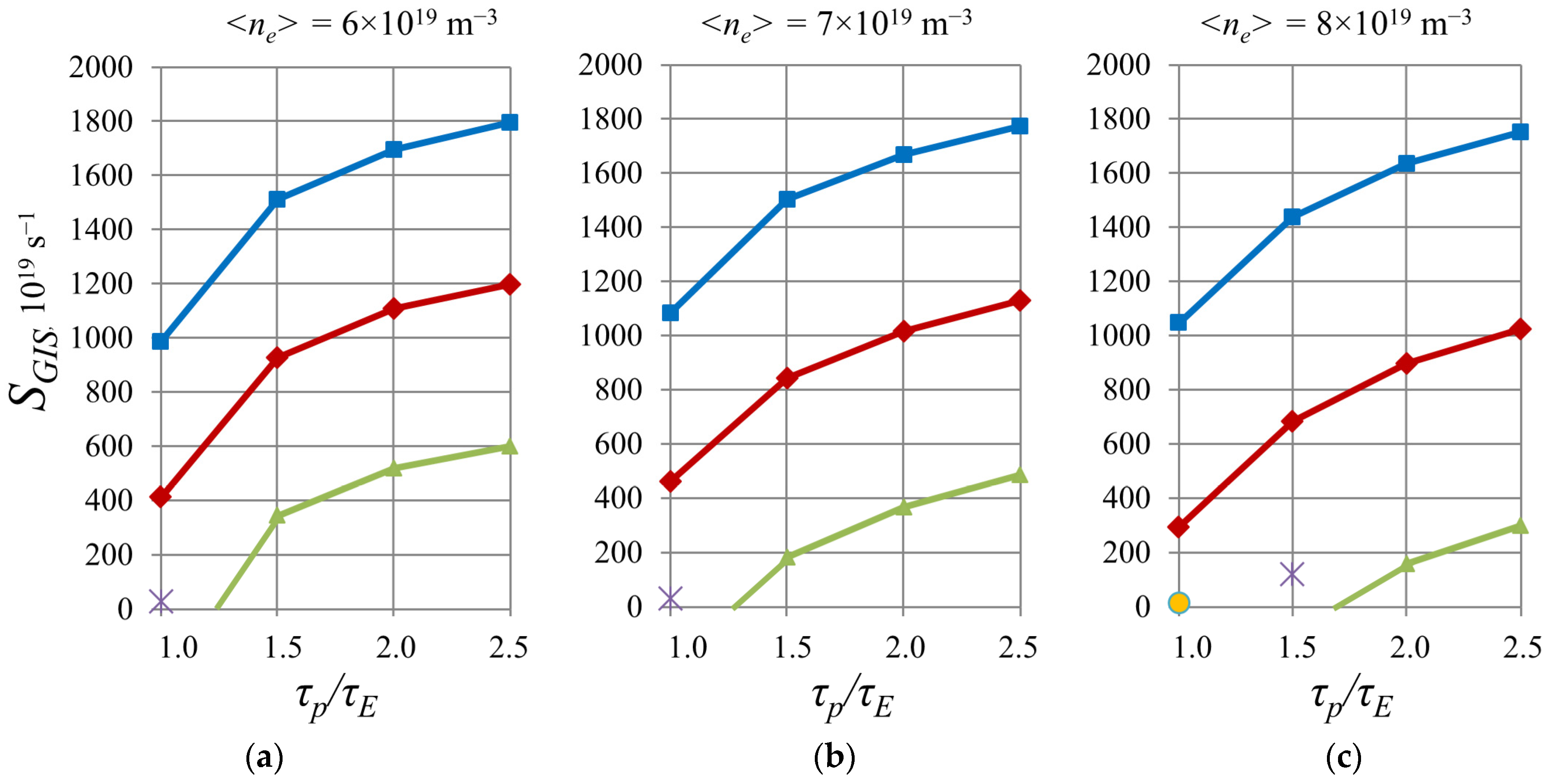



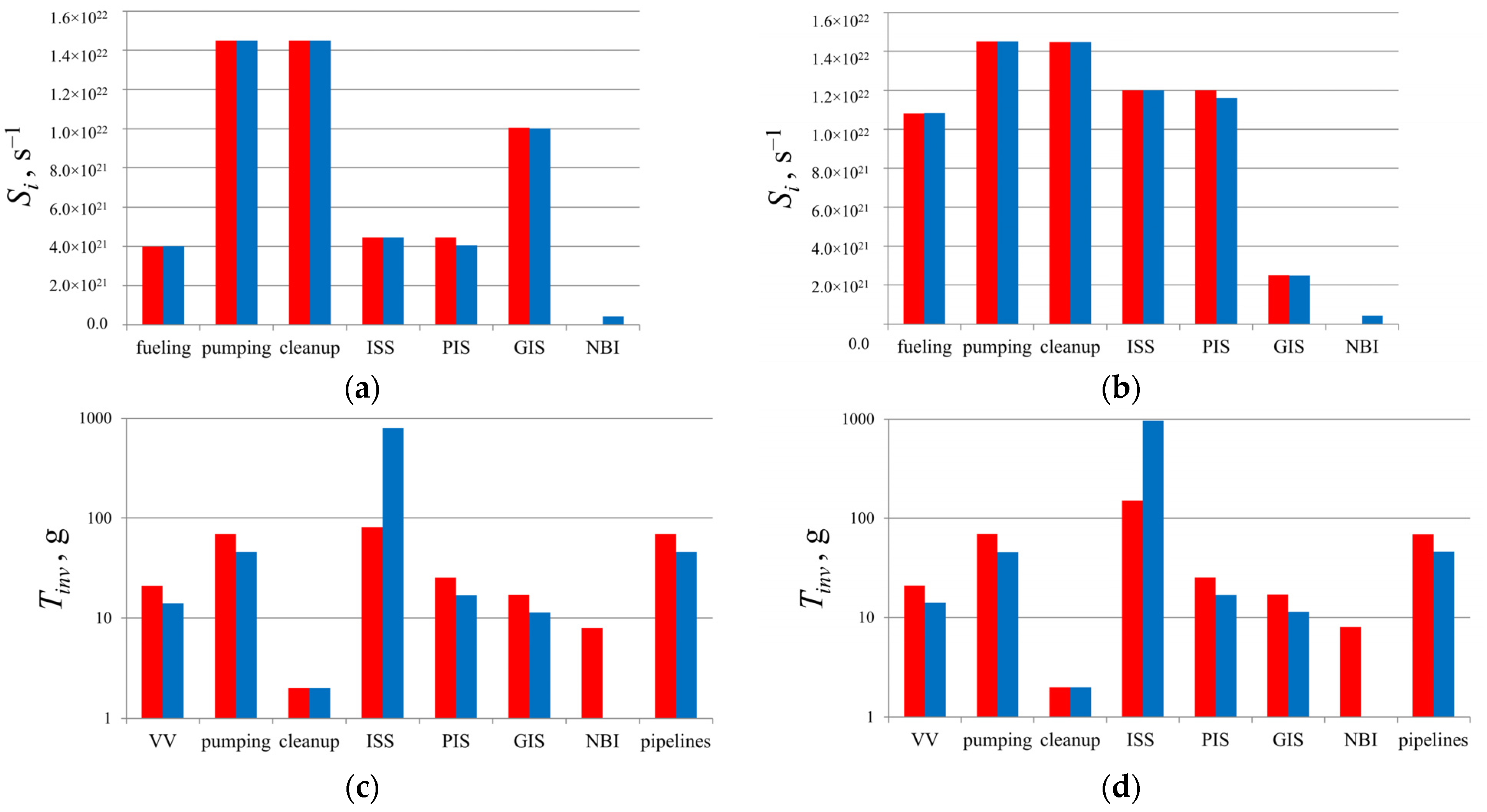
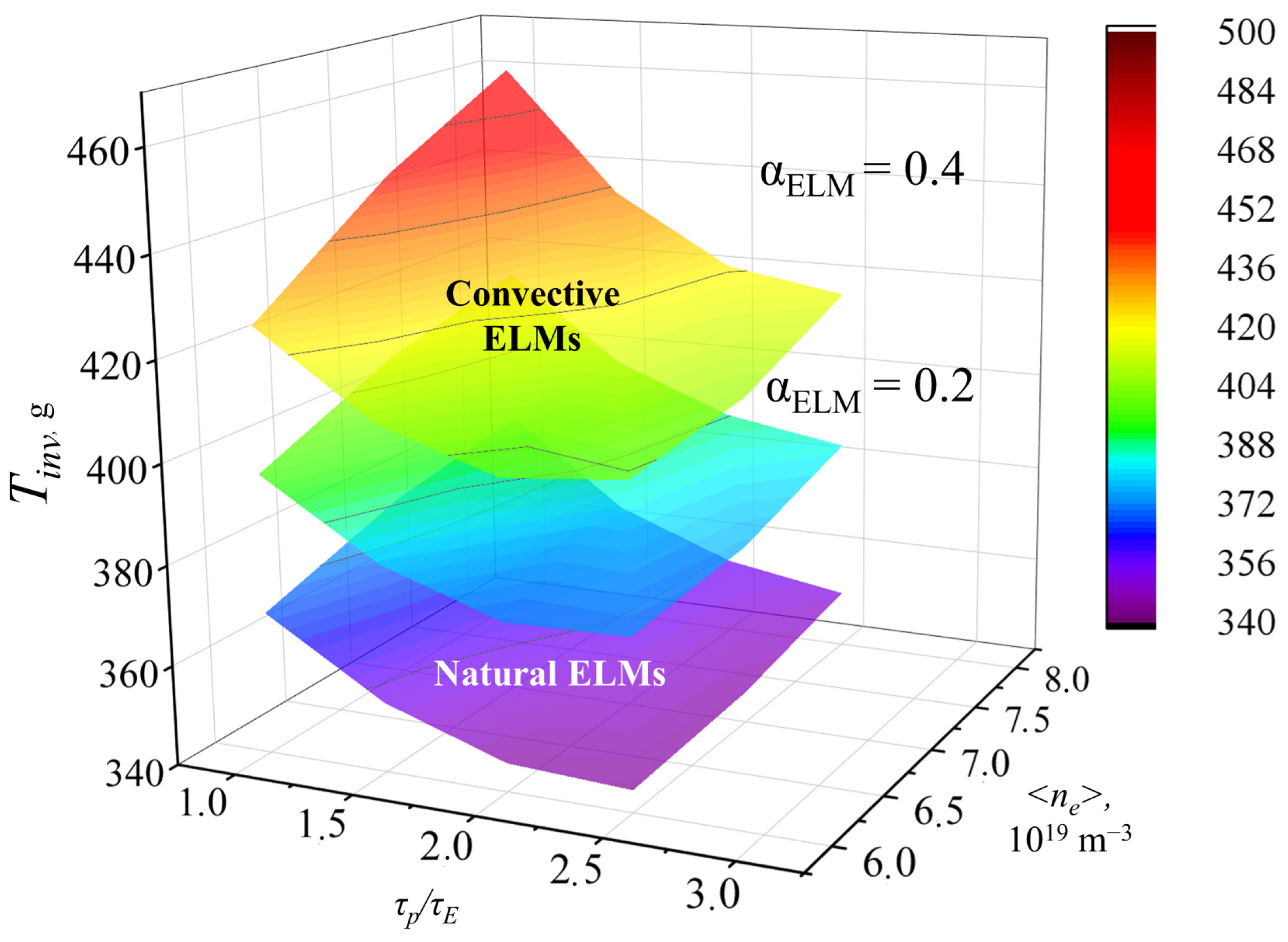
Disclaimer/Publisher’s Note: The statements, opinions and data contained in all publications are solely those of the individual author(s) and contributor(s) and not of MDPI and/or the editor(s). MDPI and/or the editor(s) disclaim responsibility for any injury to people or property resulting from any ideas, methods, instructions or products referred to in the content. |
© 2023 by the authors. Licensee MDPI, Basel, Switzerland. This article is an open access article distributed under the terms and conditions of the Creative Commons Attribution (CC BY) license (https://creativecommons.org/licenses/by/4.0/).
Share and Cite
Ananyev, S.; Kukushkin, A. Calculation of Consistent Plasma Parameters for DEMO-FNS Using Ionic Transport Equations and Simulation of the Tritium Fuel Cycle. Appl. Sci. 2023, 13, 8552. https://doi.org/10.3390/app13148552
Ananyev S, Kukushkin A. Calculation of Consistent Plasma Parameters for DEMO-FNS Using Ionic Transport Equations and Simulation of the Tritium Fuel Cycle. Applied Sciences. 2023; 13(14):8552. https://doi.org/10.3390/app13148552
Chicago/Turabian StyleAnanyev, Sergey, and Andrei Kukushkin. 2023. "Calculation of Consistent Plasma Parameters for DEMO-FNS Using Ionic Transport Equations and Simulation of the Tritium Fuel Cycle" Applied Sciences 13, no. 14: 8552. https://doi.org/10.3390/app13148552
APA StyleAnanyev, S., & Kukushkin, A. (2023). Calculation of Consistent Plasma Parameters for DEMO-FNS Using Ionic Transport Equations and Simulation of the Tritium Fuel Cycle. Applied Sciences, 13(14), 8552. https://doi.org/10.3390/app13148552




